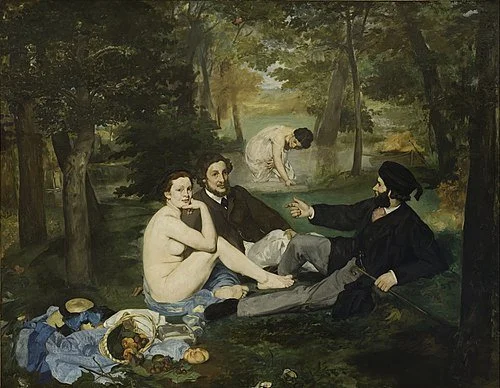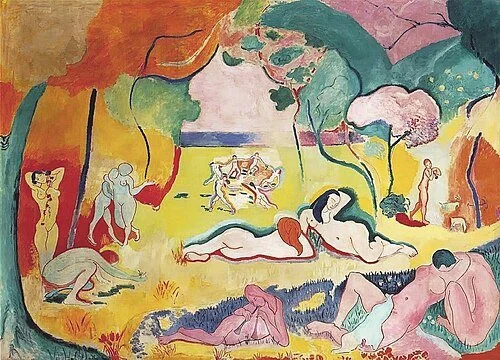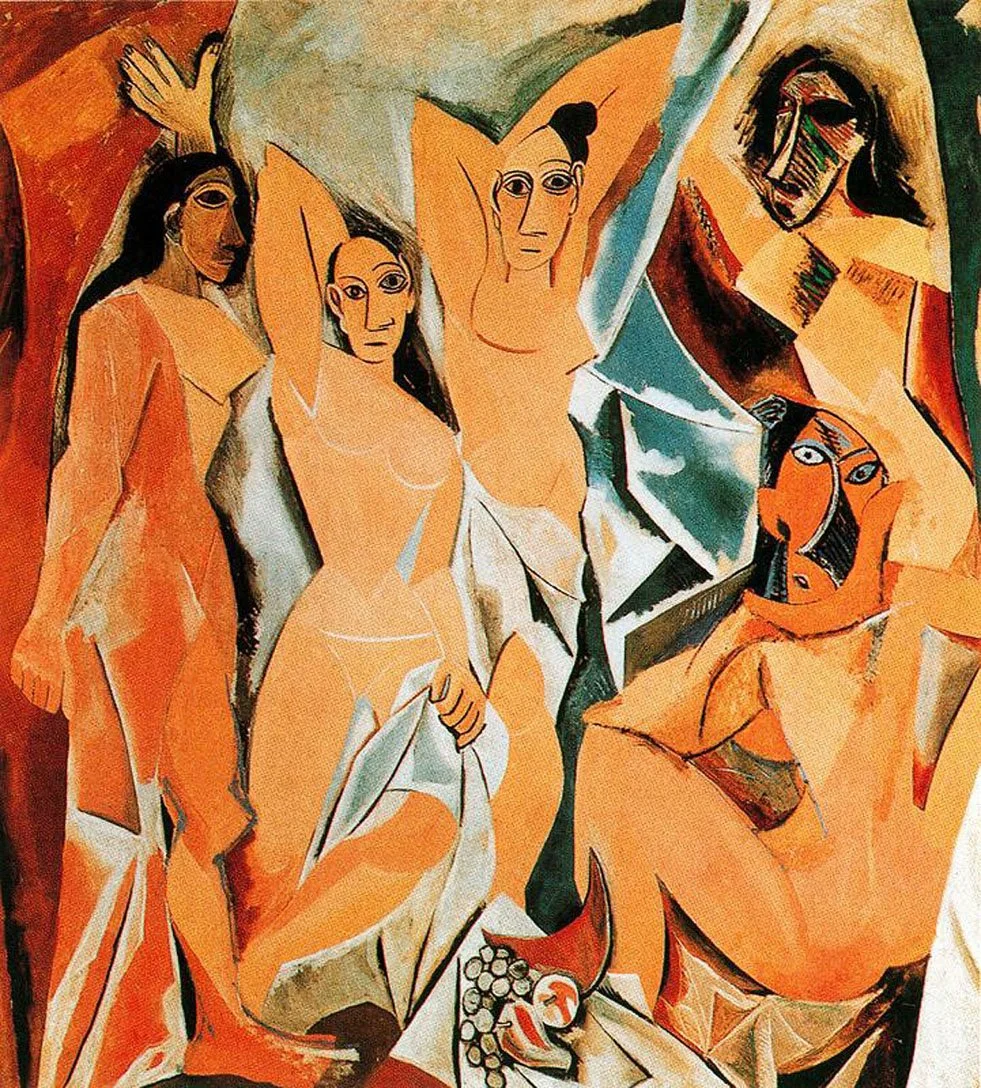The Impact of Édouard Manet’s ‘Luncheon on the Grass’ on Henri Matisse & Pablo Picasso
Édouard Manet’s Luncheon on the Grass (Le Déjeuner sur l'Herbe, 1863) is a groundbreaking painting that challenged both the artistic and political standards of the nineteenth century. Luncheon on the Grass depicts two fully clothed men accompanied by a nude woman in the foreground and a lightly dressed woman in the background. Originally titled The Bath (Le Bain), Manet intended to draw attention to the woman in the background as well, implying that she was getting ready to bathe in the river, and therefore would be undressing in front of the two men with them.
When this painting was first exhibited at the Salon des Refusés in 1863, it caused plenty of controversy. Previously, nude figures were only portrayed in art when the painting had a mythological or religious subject. Here, Manet painted a nude woman in an everyday, outdoor setting. The model used for this painting was his friend and favorite model, Victorine Meurent. Painting a female friend nude only further upset the public because it was seen as vulgar.
Adding to the shock the public felt at the woman’s “indecency”, she stares out directly at the viewers, as if personally challenging or “provoking” the public herself. The painting measures 6.8 feet tall by 8.7 feet wide, making her nude body and direct stare hard to miss. During the mid-nineteenth century, paintings of this size were reserved for “high art”, such as religious paintings. Because Manet used this scale for a secular painting, he challenged academic traditions, upsetting the public.
Manet also challenged artistic standards in this piece. Combining elements of Realism and Early Impressionism, he uses visible brushstrokes, flat areas of color, and a warped use of perspective. Although Manet was inspired by popular Renaissance works such as The Judgement of Paris by Raphael, Manet modernized the scene by putting contemporary figures in a setting that blurred the line between high art & classical life and low art & everyday life.
Henri Matisse’s The Joy of Life (Le Bonheur de vivre, 1905-1906) is another groundbreaking painting that challenged artistic conventions and societal standards. Like Luncheon on the Grass, the setting of this work is a natural environment. The Joy of Life depicts nude figures in various states of leisure in an idealized, utopian landscape. These figures appear androgynous, which was an intentional effort to blur conventional distinctions between men and women, emphasizing a universal pleasure. These unrealistic depictions of the human form on nude figures broke traditional artistic standards, shocking the public.
Matisse is widely considered the father of fauvism, a twentieth century art movement focusing on bold, unnatural colors and visible brushstrokes. The Joy of Life is a prime example of this movement, using vibrant colors for emotional impact as opposed to realistic representation. These color palettes were seen as aggressive and mixed with the bold brushwork of fauvist works, they caused an outrage from the public. One art critic nicknamed this group of artists “fauvists”, or “wild beasts”, which is where the term for the movement originated.
Matisse was also inspired by classical works of art, such as Agostino Carracci's engraving Reciproco Amore (Love in the Golden Age, 1589-1595). While not directly inspired by Manet’s Luncheon on the Grass, Manet paved the way for artists after him, such as Matisse, to test societal and artistic norms.
Both of these paintings draw inspiration from classical sources and feature nude figures in a natural setting, challenging the public. They individually broke traditions, defied perspective, and influenced the respective art movements Manet and Matisse were a part of.
With a more direct connection to Luncheon on the Grass came Pablo Picasso’s Les Demoiselles d'Avignon (1907). Picasso was heavily inspired by Luncheon on the Grass, bordering on an obsession. He created a series of works based on the painting, including 27 paintings, 150 drawings, and a handful of prints. While Picasso was arguably also inspired by The Joy of Life, specifically Matisse’s unrealistic depictions of the human form*, Picasso spoke directly about Manet’s work.
“When I see Manet’s Lunch on the Grass I tell myself there is pain ahead.”
*Clear inspiration from The Joy of Life
Les Demoiselles d'Avignon presents nude women outside of a brothel, posed to entice passersby inside. The title of this painting refers to Avignon Street in Barcelona, a known location for prostitutes. In comparison to Luncheon on the Grass, these women are also staring directly at the viewer on a grand scale, with the final artwork size measuring 8 feet tall by 7 feet and 8 inches wide. In both cases, the nude women portrayed in each painting are confrontational rather than idealized. And depicting prostitutes as the subject of any painting was far from the standard of art at the time. Picasso even waited nine years before displaying this piece to the public, yet it was still received negatively when it was first exhibited in 1916.
Like Manet and Matisse, Picasso was an artist who experimented with new styles while drawing on the works of prior artists. Les Demoiselles d'Avignon specifically took inspiration from Manet, but also from African masks and sculptures. Co-founder of the cubist movement, alongside Georges Braque, Picasso’s artwork challenged traditional representation by combining different perspectives and geometric angles of the same view, creating abstract and fragmented pieces. Abandoning traditional perspective and anatomical accuracy on top of his subject matter in this artwork, Picasso was criticized by the public.
Pushing the boundaries of style, politics, and art itself, Manet, Matisse, and Picasso all created important yet controversial artworks. Édouard Manet’s work helped paved the way for Impressionism, Henri Matisse pioneered Fauvism, and Pablo Picasso transformed twentieth century art. All of these artists played key roles in the progression of art and society by challenging the public on what was seen as acceptable and creating works they believed in. Because Manet broke away from traditional academic art, modern painting began to evolve. His influence inspired artists like Matisse and Picasso to push boundaries even further, making Luncheon on the Grass one of the most important transitional works of art.
References:
Claus, Cory. “6 Interpretative Copies of Édouard Manet’s Luncheon on the Grass.” TheCollector, www.thecollector.com/eduard-manet-luncheon-grass-copies/.
Édouard Manet, Le Déjeuner sur l'herbe, 1863, oil on canvas, Musée d’Orsay, Paris.
Pablo Picasso, Les Demoiselles d'Avignon, 1907, oil on canvas, \(243.9\times 233.7\) cm, The Museum of Modern Art, New York. Digital Image © The Museum of Modern Art/Licensed by SCALA/Art Resource, NY. Copyright © 2025 Estate of Pablo Picasso / Artists Rights Society (ARS), New York.
Matisse, Henri. The Joy of Life (Le Bonheur de vivre). 1906, The Barnes Foundation, Philadelphia.




